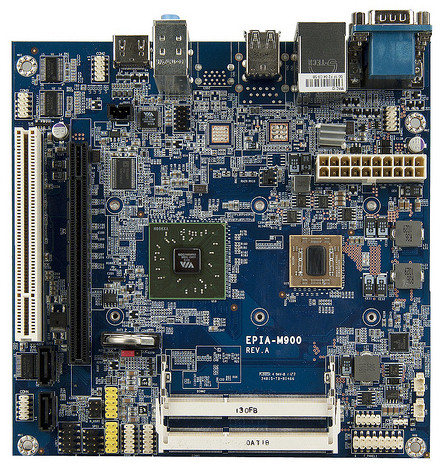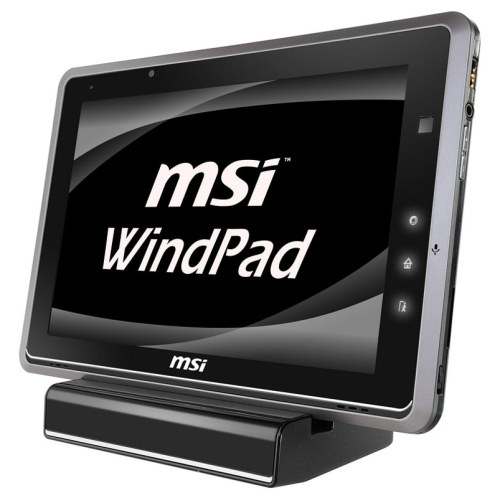 |
||
|
||
| ||
VIA Launches VIA EPIA-M900 Mini-ITX Board With VIA Nano X2 E-Series Dual-Core CPU Toshiba Launches Highly Sensitive CMOS Image Sensor With Back Side Illumination MSI Launches New WindPad 110W Tablet PC VIA Launches VIA EPIA-M900 Mini-ITX Board With VIA Nano X2 E-Series Dual-Core CPU VIA Technologies announced VIA EPIA-M900, its first Mini-ITX board to feature a 1.6GHz 64-bit VIA Nano X2 E-Series dual-core processor. The novelty also offers the VIA VX900 unified all-in-one media system processor, supports up to 8GB of DDR3 system memory and features the VIA ChromotionHD 2.0 video processor.  64-bit VIA Nano X2 E-Series dual-core processors include VIA VT virtualization, a technology that allows legacy software and applications to be used in virtual scenarios without impacting performance. The VIA AES Security Engine offers hardware-based data encryption on the fly, an essential tool in content protection and system security. The VIA ChromotionHD 2.0 video engine boasts comprehensive hardware acceleration for the latest VC1, H.264, MPEG-2 and WMV9 HD formats at screen resolutions of up to 1080p without affecting CPU load.  The VIA EPIA-M900 also features the VIA Vinyl VT2021 HD audio codec which supports Blu-ray and HD DVD Audio Content Protection. Rear panel I/O includes a Gigabit LAN port, an HDMI port, a VGA port, four USB 2.0 ports, one COM port and three audio jacks. An onboard PCIe x16 slot (up to PCIe x8) and one PCI slot is accompanied with pin headers providing one dual channel 24-bit LVDS support (including backlight control), an additional three COM ports, a further four USB 2.0 ports and one USB device port, LPC support, 2 Digital I/O, SPDIF out and an SMBus header. Source: VIA Technologies Toshiba Launches Highly Sensitive CMOS Image Sensor With Back Side Illumination Toshiba Corporation launched a new 1.12-micrometer pixel CMOS image sensor, the latest addition to its CMOS image sensor lineup, that offers the industry's smallest pixel size with enhanced sensitivity and improved imaging performance of back-side illumination technology (BSI). As smartphones get smaller and their image sensors continue to offer higher resolutions, now in a range from 5 megapixels to 8 megapixels, the challenge here is about smaller pixels, where miniaturization can result in degradation of performance. BSI overcomes this and brings a new level of responsiveness to CMOS imaging. BSI sensors feature lenses on the back, on the silicon substrate, not on the front where wiring limits light absorption. Such positioning boosts light sensitivity and absorption and allows formation of finer image pixels in smaller CMOS image sensors. Toshiba has made full use of the advantages of BSI to make image pixels with the pitch of 1.12 micrometers and to pack 8.08 million of them into a 1/4-inch sensor. The company expects BSI CMOS image sensors to become the mainstream technology in portable digital devices, with applications expanding from digital cameras to smartphones and tablets. Sampling of the new sensor will begin at the end of this month and mass production will follow in the end of 2011. Source: Toshiba Corporation MSI Launches New WindPad 110W Tablet PC MSI Computer announced the first North American shipment of WindPad 110W, a tablet PC featuring the new AMD Z-01 APU with AMD HD 6250 graphics, 2GB of DDR3 RAM (up to 4GB), 32GB/64GB solid-state drive, 10-inch 1280x800 multi-point IPS touchscreen.  Other specifications and features of MSI WindPad 110W include:
The new WindPad 110W has the MSRP of $599.99 and is available for presale at Newegg and Amazon. Source: MSI Computer
Write a comment below. No registration needed!
|
Platform · Video · Multimedia · Mobile · Other || About us & Privacy policy · Twitter · Facebook Copyright © Byrds Research & Publishing, Ltd., 1997–2011. All rights reserved. |